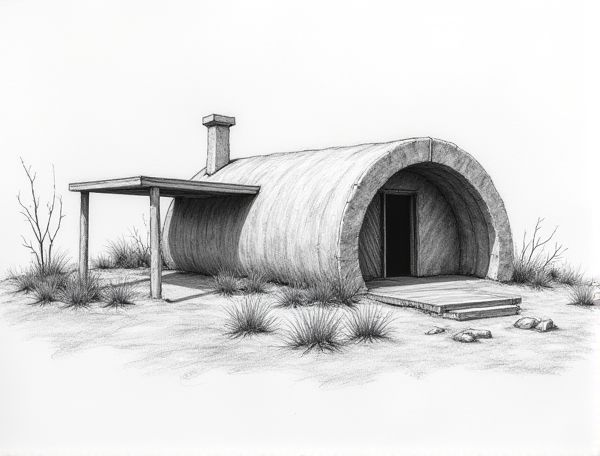
Photo illustration: Sustainable home design with earthbag construction
Earthbag construction offers an eco-friendly and cost-effective solution for sustainable home design by utilizing natural materials and promoting energy efficiency. Explore how incorporating this innovative technique can reduce your environmental impact and enhance your living space by reading more in the article.
Introduction to Earthbag Construction
Earthbag construction utilizes polypropylene bags filled with natural materials like soil, sand, or gravel to create durable, eco-friendly walls. This affordable building technique offers excellent thermal insulation, seismic resistance, and sustainability by reducing reliance on conventional construction materials. Your home designed with earthbag construction will benefit from energy efficiency and a reduced environmental footprint.
Benefits of Sustainable Home Design
Sustainable home design reduces energy consumption and lowers utility bills by utilizing renewable materials and energy-efficient systems, promoting environmental responsibility. Your investment in green building practices enhances indoor air quality and increases property value, contributing to a healthier and more cost-effective living space.
Key Principles of Earthbag Building
Earthbag building utilizes natural materials like soil, sand, and clay packed into polypropylene or burlap bags, creating highly durable and energy-efficient walls. This method emphasizes thermal mass for temperature regulation, seismic resistance through continuous reinforcement, and sustainability by using locally sourced, low-cost materials. Proper drainage, moisture barriers, and structural integrity are essential to maintain longevity and withstand environmental stresses.
Environmental Impact of Earthbag Homes
Earthbag homes significantly lower environmental impact by utilizing natural, locally sourced materials like clay, sand, and earth, which reduce carbon emissions compared to conventional construction. Their high thermal mass provides energy-efficient insulation, minimizing your heating and cooling needs while promoting sustainability. These structures also support waste reduction and are often biodegradable, making them an eco-friendly choice for environmentally conscious home design.
Essential Materials and Tools
Essential materials for home designing include high-quality hardwood, durable drywall, and moisture-resistant insulation, which ensure structural integrity and long-lasting aesthetics. Your toolbox should contain precision measuring devices, quality cutting tools, leveling instruments, and ergonomic hand tools to execute designs accurately and efficiently. Selecting eco-friendly and sustainable materials enhances your home's environmental footprint while optimizing overall design performance.
Step-by-Step Earthbag Construction Process
You can create a durable and eco-friendly home by following the step-by-step earthbag construction process, starting with site preparation, laying the foundation, and filling polypropylene bags with local soil mixed for optimal compaction. Each layer is carefully stacked and tamped to ensure structural stability, with barbed wire placed between courses for added strength, culminating in a plastered finish that protects against weather and enhances insulation.
Energy Efficiency in Earthbag Homes
Earthbag homes maximize energy efficiency through their thick, insulating walls that maintain consistent indoor temperatures by minimizing heat transfer. The natural thermal mass of earth-filled bags reduces reliance on artificial heating and cooling, leading to significant energy savings and sustainable living.
Design Ideas for Sustainable Earthbag Houses
Earthbag houses offer exceptional thermal insulation and durability by utilizing locally sourced, natural materials such as clay, sand, and straw-filled bags. Incorporating passive solar design, rainwater harvesting systems, and green roofing enhances your sustainable living experience while reducing environmental impact.
Common Challenges and Solutions
Common challenges in home designing include limited space utilization, budget constraints, and balancing aesthetics with functionality. Your best solution involves prioritizing open layouts, choosing cost-effective materials, and incorporating smart storage options to maximize comfort and style.
Future Prospects of Earthbag Sustainable Housing
Earthbag sustainable housing offers promising future prospects with its cost-effectiveness, durability, and eco-friendly materials that reduce carbon footprints. Innovations in natural insulation and modular designs enhance structural integrity and energy efficiency, making earthbag homes viable for various climates. By embracing earthbag construction, Your home design can contribute to sustainable living and long-term resilience against environmental challenges.
 homedesy.com
homedesy.com